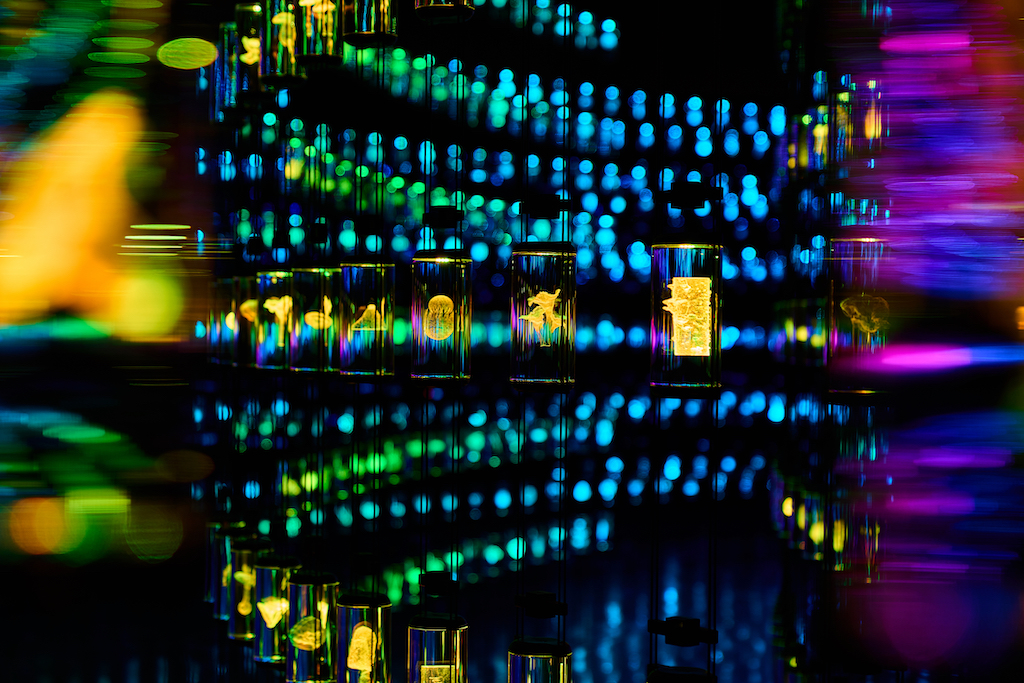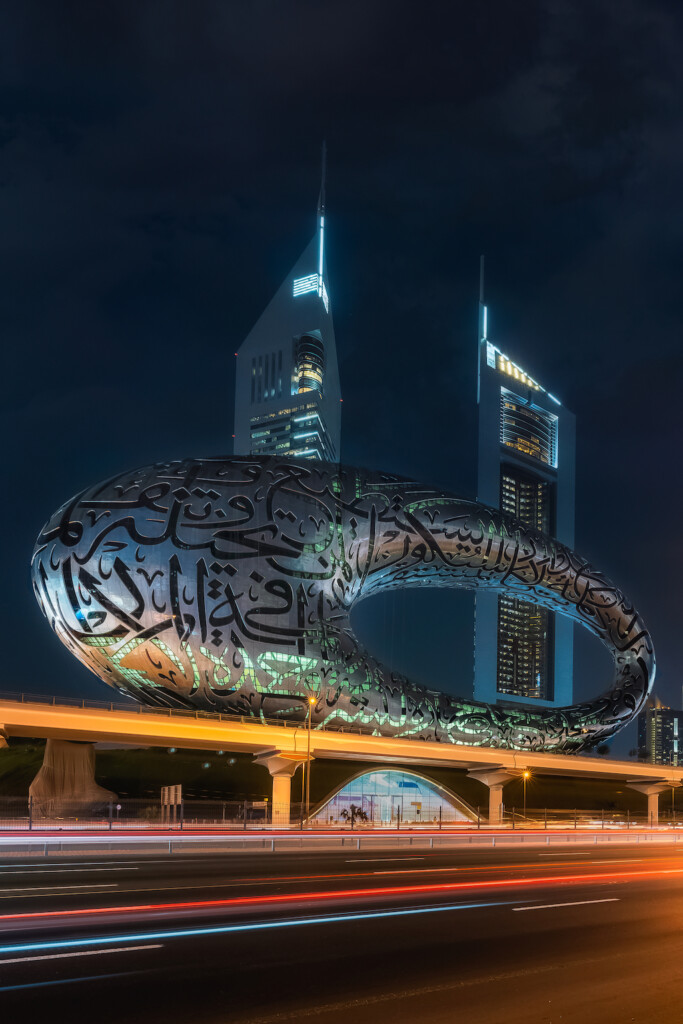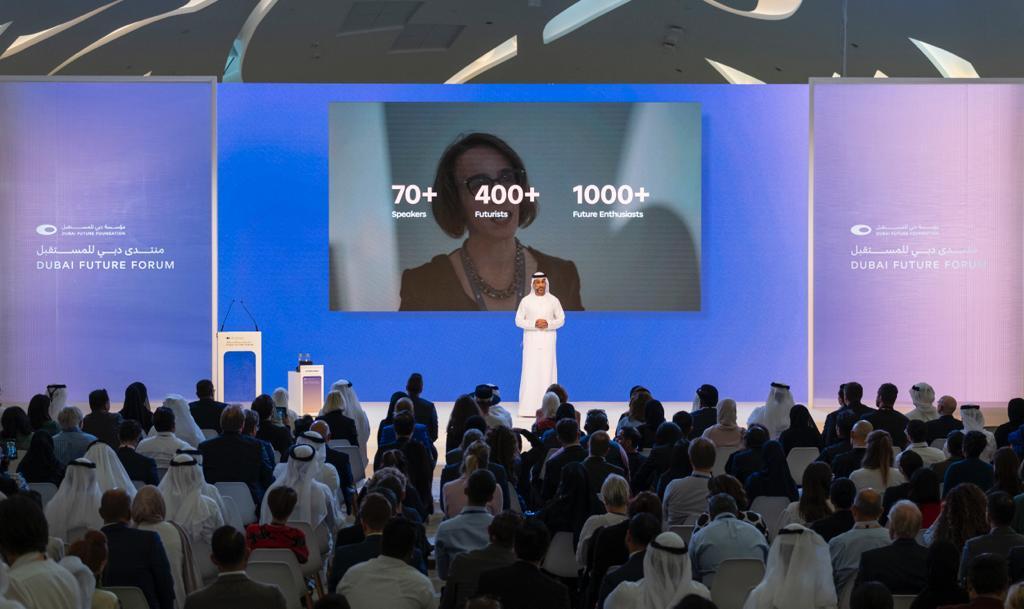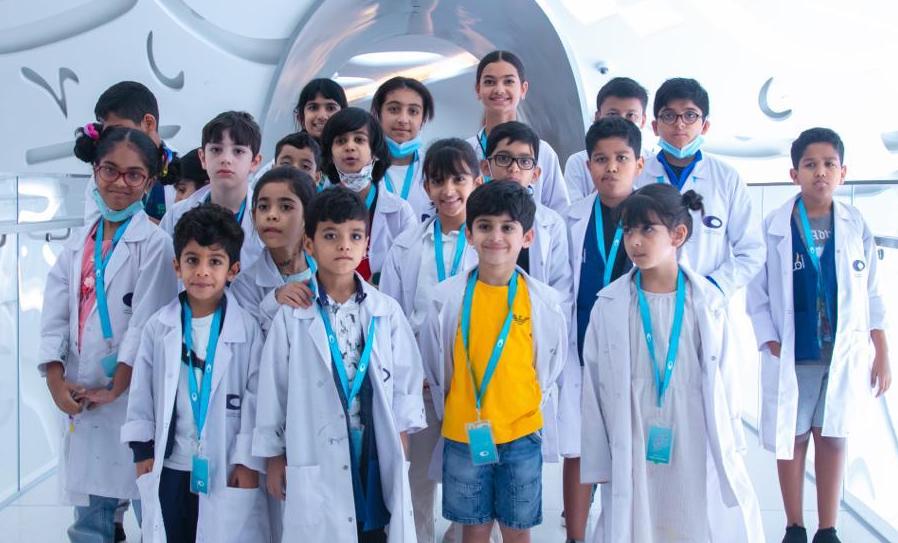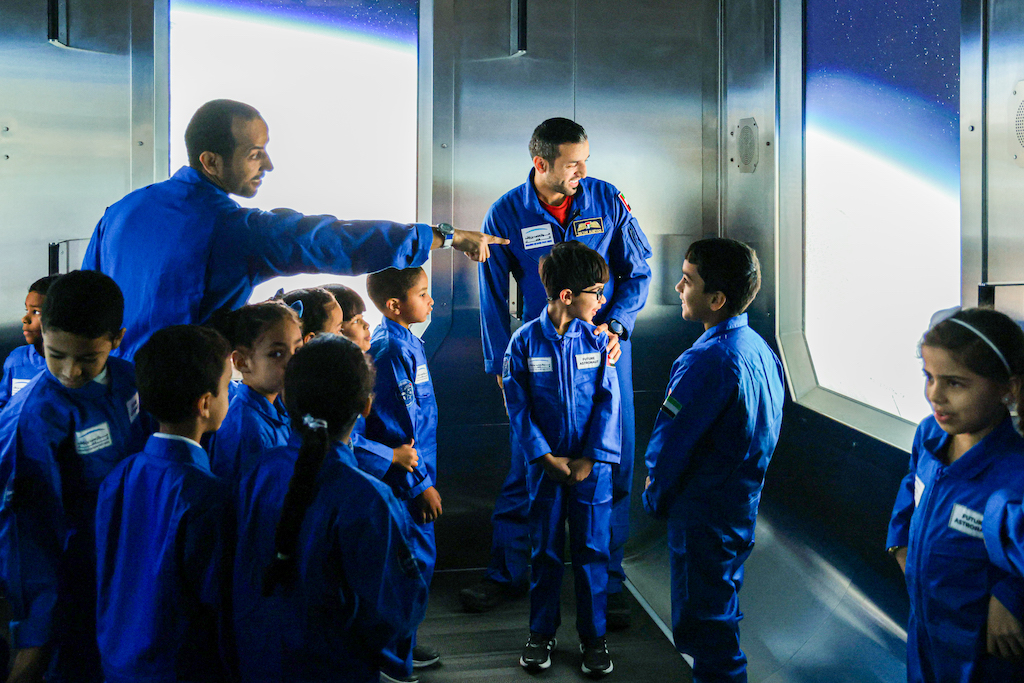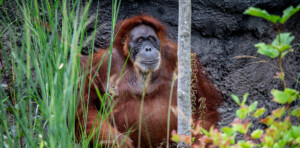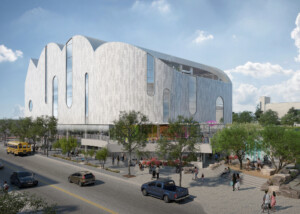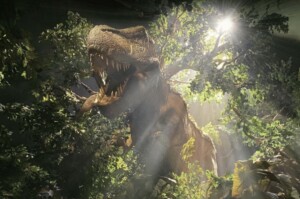Lath Carlson, executive director of the Museum of the Future, last spoke with blooloop in 2019 when the museum in Dubai was still a concept. Now, it has been open for 12 months.
“The most unexpected thing has been how busy we’ve been,” Carlson says, as he reflects on the first year of operation.
“We’re now at over 12 months, and sold-out every day, which is incredible. For the first couple of months, we accepted it as that opening effect of everyone rushing to visit, but now we’re sold out until mid-next month, and that’s pretty common, so we’re adjusting to the reality of being an always sold-out attraction. We’ve heard we’re in company with the Vatican as the hardest-to-get tickets in the museum world.”
The museum is open for 12 hours a day.
“At that rate, we can accommodate a million paying guests per year, which is where we’re assuming we’ll sit. In February, we sold our millionth paid ticket.”
A hopeful vision
Dubai’s Museum of the Future, he explains, is rooted in the sort of hopeful vision for which the world is hungry. It is an optimistic portrayal of where humanity is going, but one grounded in the realities of the challenges we face.
He comments:
“We look particularly at things like climate change as a core topic, but try to present an optimistic and creative response to that challenge. That is the direction we have stuck with, and I think that accounts for some of the response. People really appreciate that particular perspective.”
“Obviously, events have grown a bit more dire since we started the process. A few days after opening, the situation in Ukraine started. If we look at the global weather events that we’ve seen in the last couple of years, the impacts of climate change are being increasingly felt directly by people.
“That is part of the reality that we’re facing. It gives an even greater urgency, I think, to that sort of hopeful message grounded in collective action and national and international responses.”
Encouraging optimism at Dubai’s Museum of the Future
Optimism, he feels, can be a choice:
“The timeframe of the museum core exhibits being 50 years in the future helps a bit. When we think on a 50-year time horizon, we know that maybe 30 or 40 years from now the pandemic will not seem as significant of an event as it does to us right now, in the shorter timeframe.”
“We realised early on in this project that the counter-narrative, that dystopian dark story, is pervasive. We see it everywhere in the media, so that is the pervasive narrative. I think it’s increasingly important that there are people countering that narrative. And, as our creative director says, the darker version is the easy narrative. All you do is take something that’s bad today and make it worse in the future. That’s much simpler than working out how to make it better in the future.”
Essentially, it is lazy storytelling.
“The story we are telling is primarily a human-driven story and not a technology-driven story,” Carlson says. “I think that has largely resonated with people.”
A different aesthetic
The museum’s storytelling has resonated with around 90% of people, to be precise. He elaborates on this:
“If you look at our review scores, 90% of people that visit the museum love it. But about 10% struggle, because they expect it to be primarily a technology-driven experience, and they expect to see technologies that they’ve never seen before. The common quote that you’ll see is, ‘There’s nothing ‘futuristic’ there’. What they really mean is that there’s nothing that conforms to their idea of ‘futuristic’, which is based on 30-year-old movies, like Bladerunner.”
“We have very intentionally created a different aesthetic. Even where we’re talking about outer space exploration, we built the space out of woven 3D printed panels, rather than the stainless steel and bright plastic look of most space environments.”
The idea, he explains, was partly in order to be regionally responsive to the aesthetic of the Middle East:
“It was also just more pleasant; something you might actually want to live in as opposed to the International Space Station. No one who has actually been there says they’d ever want to live in a space like that again if they have a choice.”
Robodog greets guests at Dubai’s Museum of the Future
Given the Museum of the Future’s consistent popularity, one challenge has been finding ways to entertain people queuing.
“Because it’s time ticketed on 30-minute increments, most people will wait almost 30 minutes,” Carlson explains:
“Early on, we started flying robotic inflatable animals around in the lobby. Since we have a three-storey space, it was a venue to do that. It was such a hit that now we’ve expanded, and bring out the robodog. I was over in the museum just now. The robodog was out greeting guests, walking around the lobby and entertaining people.
“It really is an effective way to create an exciting experience while people are queuing.”
Keeping the programming fresh
Another interesting innovation is the programming:
“We have added a lot of public programming to the Museum of the Future targeted towards people that live in Dubai. Because we’re generally sold out three, four weeks in advance, and almost no one that lives here plans that far ahead – myself included – everyone I know has said, ‘No, we haven’t come to the museum yet, because you’re always sold out, and when it comes to the weekend, we can’t get in.’
“What we find is with the public programming that’s more accessible to people, so we’ve actually added a lot. We went from essentially no public programming other than a few speakers, to multiple events every week.
“Every event so far has sold out. The response has been incredible. We’ve had a sketching workshop where people were outside learning how to sketch the museum, which is a unique building, but we’ve also done more traditional things, like 3D printing and drone workshops, and using AI for art: things that you might not associate with the museum.”
“Last week we had Idris and Sabrina Elba, who were in town, come to the museum and do a talk. They do a lot of work with the UN on sustainable development, so we were able to have a celebrity-driven night. About 400 people came to see them speak. We also had Deepak Chopra, who came to do a guided meditation with the audience. This was fantastic because it tied perfectly into our Al Waha exhibition, all about health and wellness, which is one of his favourite spaces.
“We’ve really been able to bring in different perspectives through the programming, which has been popular with people that live here, but who still maybe haven’t even seen the museum.”
Museum of the Future reaches Dubai audiences and beyond
Dubai is one of the world’s most-visited cities, and commenting on the Museum of the Future’s reach in its first year, Carlson says:
“Dubai is TripAdvisor’s number one destination for last year and this year for international travel. It has been amazing to see the scope and breadth of the museum’s reach. We’ve now had visitors from over 144 countries; an incredible global reach.
“Interestingly, for museums, our core demographic is between 25 and 45 years old, which for most museums is the missing group. Art museums tend to attract an older demographic, while science centres and children’s museums get the younger end of the range. We’re actually sitting right in the middle, with a pretty even gender split.
“We’re appealing to a broad audience. That was intentional; all the way through the process, we wanted to ensure we remained as broadly accessible as possible.”
The museum has been designed to be accessible:
“Our children’s floor, especially, has been designed specifically for people of all abilities, and for neurodiverse people. That was a very intentional part of the design that has really paid off, in terms of keeping our reach as broad as possible.”
Museum of the Future has a positive impact on Dubai
22 Heads of State have visited the museum so far:
“Just last week we had three Heads of State visit. The President of South Korea was at the museum recently, and many other world leaders. People at all levels are engaging with the museum. The response has been pretty incredible in terms of every metric.”
In fact, he adds:
“I literally walked down here from a meeting with the consulting firm that we hired to measure the economic impact of the museum. While I can’t publicly state those numbers yet because we haven’t released them, the direct impact of the museum in Dubai is a figure in the hundreds of millions. There is also a much larger figure for total impact, which is quite gratifying to see.”
Ironically, he adds:
“I was at a conference not long ago speaking about this to some people in the hospitality industry who didn’t realise that museums could be much of an economic driver.”
In-person experiences are key
Carlson has made a deliberate choice not to attempt to extend the Museum of the Future’s reach digitally. He explains:
“It is something we have been quite intentional about. When the pandemic hit, everybody started deploying digital strategies. And most of them abandoned them in fairly short order because it turns out it’s a very different thing to do.”
“Many people didn’t realise that the people they were competing with had been doing this for decades. There is so much marketing behind it, so much building up in terms of audiences. For a museum to think they can just pivot turns out to be so much more difficult than anticipated. We really had to think about it.
“For us, the whole idea is that the museum should be a multi-sensory experience and a social one.”
Accordingly:
“We all collectively decided early on in the pandemic that no, we weren’t going to change that strategy. We were hopeful that we would come out of the pandemic, and things would go back, more or less, to normal. So we put all of our energy into the physical museum.”
Digital tools and accessibility
Interestingly, there was a companion digital app available to visitors when Dubai’s Museum of the Future first opened a year ago:
“No one was particularly interested in it,” Carlson says. “We haven’t had a single person actually request it.”
“Now we’re actually getting ready to release a new version of a digital tool, but primarily it’s all about language accessibility and for people that want more information. In the exhibitions, we very intentionally keep everything very in-world; there’s no didactic museum text. In all the immersive experiences, you’re really in the world.
“There is a certain percentage of guests who want to know more about the science behind it and the backstory. So, the new digital tool will focus on supplying that kind of information, as well as supporting language accessibility. We’ve had guests from all over the world, and most are not native speakers of Arabic or English, our two major main languages.”
New types of museums
Having established that the Museum of the Future is an in-person experience rather than something to be reimagined in digital form, Carlson says:
“We are what we are. Let’s figure out how to accommodate as many people as we can, but also be an inspiration to others that may be thinking about building similar institutions.”
He adds:
“There is an organisation, FORMS: Futures-Oriented Museum Synergies; an international group focused on museums that are looking towards the future. It has become an increasingly robust organisation over the last three-and-a-half years.”
“It started back in 2019. The first meeting was organised by the group behind the Museum of Tomorrow (Museu do Amanhã) in Rio de Janeiro. Since then we’ve had virtual meetings, and are now back to physical convening, and it has become a strong and, I think, very different type of organisation. Being a part of that has been really great for us, but also really good for the members that are in an earlier stage of development of their institutions. They can look at our example and see, you know, one version of a successful museum.
“The Futurium in Berlin is another member of that group. They, too, have been very successful, in a very different model. It’s good to see that there are different takes on this that have all been doing quite well.”
Dubai’s Museum of the Future challenges conventions
Throughout his career, from his time at the Tech Museum of Innovation and the Living Computers Museum, Carlson has a history of challenging conventions around museums. Is that something he feels he is still doing in his present role?
He considers:
“That’s interesting. I guess we are challenging convention, in that we’re a future-oriented museum. I will say that some visitors have been a little sceptical.”
“Ian Blatchford from the Science Museum in London finally got a tour about six weeks ago, when he was here. At the end of the tour, he said to me that he had been rather sceptical, but then, having seen what we’re doing, he realised it is equally valid as a type of museum. I think that was quite gratifying, but it took him seeing it to really understand that.”
This, he says, can be a challenge in the museum world:
“People tend to be a bit sceptical because they just haven’t seen it before. We’ve had other visitors, like Larry Dubinski from the Franklin Institute in Philadelphia, who came right after we opened. I used to work at the Franklin. He had the same response. He came and was absolutely blown away by the experience, and understood then that it was just something different.”
Thinking about the future
“If we think back to other types of new museums, such as the Boston Children’s Museum when it first opened, or the Exploratorium in San Francisco, for most of them, it took a good decade for that concept to be considered valid. ICOM (the International Council of Museums) still doesn’t necessarily validate those kinds of museums.
“I’d say that we’re still so early in this that I think it will take a while for the museum community to understand the validity of future-oriented museums, and what they really are. In that sense, this museum is pushing on the conventions.”
In other ways, he says, it can be important to be conventional:
“We don’t want to push on too many dimensions at once. So, we are using the tools of museology to present these futures, and very intentionally framing ourselves as a museum. We are using the conventions of museums, and applying them to things that might happen, as opposed to things that might have happened in the past.”
This is something to which he has been giving some thought:
“Even historical museums are only giving a version of the past that they think is true today. If we look at a lot of those museums, over time, that interpretation has radically changed. Is that any more – or less – valid than thinking about what a future might be? Both are speculative, in a sense. We don’t know every detail of the past, just as we don’t know every detail of the future.”
New partnerships and exhibits
In terms of exhibitions and keeping things fresh, he says:
“It’s great when your plans actually work out. We had this idea of the core exhibitions being 50 years in the future, so they wouldn’t need to be refreshed quite as rapidly. And, because they’re not technology-centric, the story lasts longer.”
“On the other hand, we do have the exhibition ‘Tomorrow, Today’. This is about what is happening in the near future, but that’s all in partnership. It has worked very well. One of our partners is Audi; as part of their partnership, they supply concept cars. We are now getting ready to install our fifth car in a year; we have already displayed four different concept cars from them, which has been a great way to keep that refreshed.
“Similarly, we have a partnership with SAP.”
Co-developing exhibits at the Museum of the Future in Dubai
The Museum of the Future’s partnership with SAP highlights leading technological innovations and expertise at SAP, addressing environmental, economic, and social challenges for future generations. Carlson comments:
“We have an interactive exhibit we’ve been co-developing with them opening now: a full exhibition component on that floor. That kind of approach of working in partnership to develop experiences has worked well, so we will continue that.”
“I think what’s most exciting for us is we are now starting the research and design phase for our first full exhibition refresh of one of the immersive experiences. The idea with the three core immersive experiences is that about three years after opening, we would either completely replace one of them or do a significant refresh.
“We have started that process now, having really learned from what works with visitors and what doesn’t work, and what their expectations and interactions are. Previously, it was all speculative; nobody had really done this before.”
Lessons from the first year
Some of the lessons learned have been, he says, rather unexpected:
“We have an exhibition where, when you leave, you pass a wall that has wishes for the future in three-dimensional letters in different languages. People really like to take the letters as souvenirs. None of us anticipated this. It’s interesting; there are certain words and certain languages that disappear first. We’re making adjustments as we go.
“One of the interesting parts of this work is seeing how people act. It’s a great laboratory for social science, and seeing how people use these spaces and interact with others in unanticipated and sometimes delightful ways.”
In the spirit of encouraging positive interaction, he adds:
“One of the breakout hits of the museum is the floor that’s focused on health and wellness with a hint of spirituality. It ends in a meditation room. That is a powerful experience for people, and they really seem to love it. The last part of the immersive experience is lying down and being quiet, having this meditative, inward-facing experience before going back out into the normal world.
“The idea was that we wanted people to leave feeling recharged and peaceful, rather than frenetic and worried. We wanted it to be a calming exit from the museum. It has been gratifying to see how well received that has been. It’s unusual for a museum experience to reintroduce you gently back into the world.”


